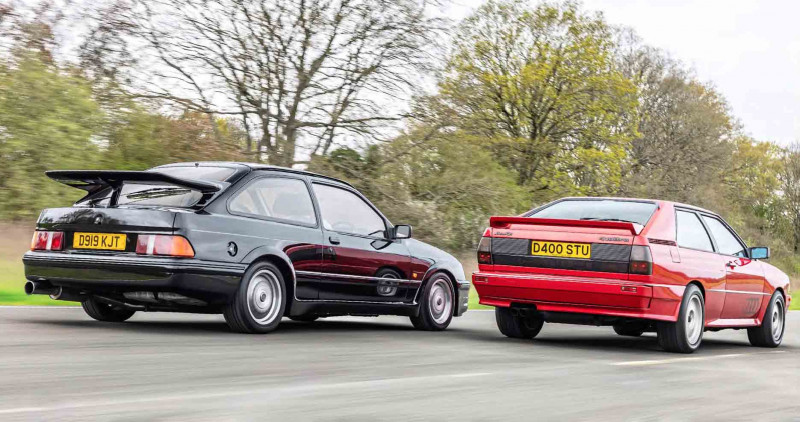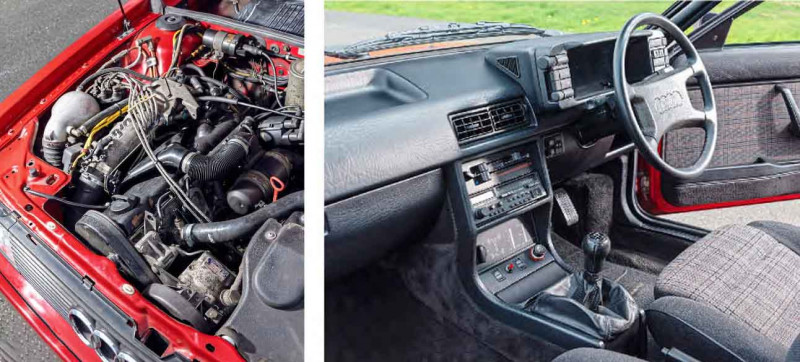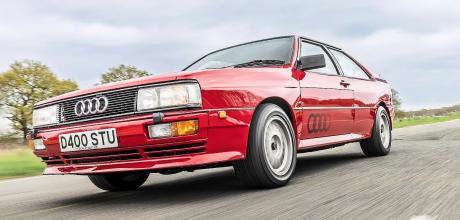1986 Audi Quattro 10v/WR
The Audi Quattro was by no means the first four-wheel-drive road car, but prior to this they were exotic curiosities or (slightly) sanitised off-roaders. The UR-quattro was something different. Previously, the performance car was largely defined by an even number of cylinders, usually naturally aspirated and rear-driven. The Audi Quattro stripped all that away with a warbling five-pot and a turbocharged surge that brought white-knuckle wastegate-whistle adrenalin to a relatively mass-market executive coupé – one that looks like it’s been pounding the weights in the gym. The sheer brutality of designer Martin Smith’s vision is still staggering. Remember – the Quattro was launched when the condom-beaked MGB was still on sale.
The Audi is otherworldly on the inside – today’s descendant of this car will have an interior that’ll be a grimly funereal monochrome environment with more screens than Wargames’ David Lightman could dream of. True, the majority of a Quattro’s dashboard is black plastic – but check out the big, chunky buttons around the instrument binnacles, and the vibrant Eton flannel cloth seat upholstery (these days you’d be lucky to get colour-contrasting stitching). It’s all wonderfully endearing. The Quattro even has its own screen – lovely red-on-black LCD instruments that, like the Astra, transport me to a simpler time, when a ‘website’ was what an insect exterminator dealt with. That goes for the driving experience too. There’s not a great deal of feel being delivered through the fairly large steering wheel, and driven in the manner of a traditional performance car, all the ironmongery seemingly trying to escape via the four rings in the snout means understeer.

No, instead it’s a case of rethinking my driving style. Fast in, point the nose, plant the throttle, ignite the KKK K27 turbocharger and believe in the talents of Ferdinand Piëch’s engineering team. Try that in a rear-wheel drive car and you’ll be picking bits of yourself out of the scenery. It’s frankly unbelievable that the Quattro is 43 years old, such is the way it deals with corners in such a no-nonsense way, and bungees from a standing start.
The Quattro foregoes traditional thrills and spills in favour of its own concoction of slow-burn satisfaction. Rather than seeing each corner as a challenge, the driver is can enjoy the satisfaction and joy of stringing an entire road together at a pace that would leave a rear-wheel drive car scrabbling (and if the going was even moderately moist, having to back off entirely). The effect that the Quattro had on the car market was seismic – soon everyone needed a car with drive to all four corners in the range, from Ford and Alfa Romeo to Mercedes-Benz and BMW. Some of these were more successful than others, and the fashion for four-wheel drive executive cars would wane somewhat in the Nineties, but fast-forward to today and nearly all performance cars have such a transmission system.
They will all be pretenders to the Audi’s legend, one that has only grown in recent years. Quenching the Quattro thirst will begin at around £22k for projects and rise to £50k for dealer-sold cars, though recent auction results for truly special examples have seen them go for rather more. Those tempted by an entry level example could well find themselves on a quest for four-ringed salvation that Frodo Baggins would blanch at. Early cars were ungalvanised, but all Quattros can rust at this age, and you’ll also need to be vigilant for signs of a blown turbo – limp performance and more smoke from the exhaust than a nightclub circa 1988.
Leaking oil coolers left untended can lead to big failures later on. Great though the digital dashboard is to look at, they’re prone to going wrong and a replacement will cost £700 – if you can find one. And make sure the centre differential locks work properly – check that the warning lights in the cabin go on and off. However, as long as the car has been cared for properly, the Quattro is a rugged, reliable machine that can pile on the miles.
Those miles will only get increasingly satisfying the more time you spend with the Quattro. Its focus on maximising potential and performance is oh-so-very-Germanic, and perhaps lacks the unhinged romance of others here – even the BMW – but a dawn blast will certainly leaving you fabulously fired up.
Owning an 1986 Audi Quattro 10v/WR
‘It had to be red, it had to be cloth and it had to be original as possible,’ says Quattro owner Micky Calcott. ‘I wanted one that could be driven and not just kept garaged.’ He’s had the car since 2020 and has spent around £8k on it. ‘I’ve spent money on the mechanicals to get them right – tightening and checking things and replacing pipes, wheel bearings and bushes,’ he says. ‘My significant investment was replacing the front and rear dampers. I chose Bilstein Sport, which are a little stiffer than the factory dampers, so AM Cars softened them for me before fitting them to get them more like the original ride.’ He recommends Illminster-based AM Cars as specialists for Quattro work, and suggests joining the Quattro Owners Club. He says the car’s strong point is its strength, and doesn’t see any weak points. ‘It’s 35 years old, so it has the usual things to be mindful of when driving and maintaining.’
TECHNICAL DATA 1986 Audi Quattro 10v/WR
- Engine 2226cc inline five-cylinder, sohc, KKK K27 turbocharger, Bosch K-Jetronic fuel injection
- Max Power 197bhp @ 5800rpm
- Max Torque 199lb ft @ 3000rpm
- Transmission Five-speed, manual, all-wheel-drive
- Steering power assisted rack and pinion ZF
- Suspension Front and rear: independent, MacPherson struts, lower wishbones, telescopic dampers, anti-roll bar
- Brakes Servo-assisted vented discs front and rear
- Performance Top speed: 138mph
- Acceleration 0-62mph (0-100kph): 6.5 seconds
- Weight 1300kg (2866lb) (dry)
- Cost new £30,199 (1988)
- Classic Cars Price Guide £22k-£50k

Five-cylinder turbo engine in earlier 10-valve form. Designer Martin Smith gave Quattro its tough attitude Differential lock console sits beneath stereo.
‘Deals with corners in a no-nonsense way, and bungees from a standing start’



Before it all came crashing down, the Eighties vibe gave us many colourful reasons to be optimistic, particularly the cars. Little wonder their appeal is growing now.
Quattro.
One word, instant picture in your mind – box wheelarches and squat, bodykitted stance; turbo, when that was a real badge of honour; clever, self-assured four-wheel drive. And red, had to be Tornado Red. It didn’t actually, but that’s how it seemed. This was the Eighties on wheels – self-assured, future-facing, successful. Not everyone enjoyed the brief, heady gold rush of the decade and for many it would end in tears, but for a while it was as if we were all infected by the feelgood factor. Just as the Sixties had an optimism that distracted Britons from the remnants of post-war austerity, the Eighties – once well into its stride – helped us forget the decay that characterised the Seventies.
Add Cosworth, E24 635CSi, GTE and Testarossa – now there’s Eighties car culture defined. Rallying and saloon racing glory, the rise and rise of German car desirability, gritty suburban hero and a big showoff fantasy just one utilities share deal away from reality. Well, maybe. And with a bang, it was over, the symbols of excess treated with either ridicule or remorse, depending on how close you were to the cocaine and champagne when the party stopped. But now look at the cars, hotter than a hairsprayed stadium rock band at the peak of its MTV video chart posturing. Just without the dry ice.
If, like me, you were too young to experience the star cars of the decade firsthand, perhaps the rash of crash, jump and roll stunt-ridden TV shows and films was as close as you got. In which case, you’ll be enthralled by our interview with Jack Gill, the man responsible for so many of those iconic stunts from a time before CGI made it all safe and unreal. You’ll just have to forgive him for all those future classics he wrecked in the line of duty. But hey, without attrition we would appreciate the survivors less.
Whatever your view of Eighties excess, you have to accept it left a colourful mark on motoring history.
Eighties heroes of the rally stage and race track are hot.